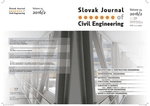
Slovak Journal of Civil Engineering
Scope & Guideline
Exploring groundbreaking solutions in civil engineering.
Introduction
Aims and Scopes
- Sustainable Construction Practices:
Research on methods and materials that enhance sustainability in construction, including the use of recycled materials and energy-efficient designs. - Structural Analysis and Design:
Studies that explore the behavior, performance, and safety of different structural systems under various loading conditions. - Urban Planning and Infrastructure Development:
Papers that address urban transport networks, the impact of transportation on urban environments, and the integration of green spaces in urban planning. - Environmental Engineering:
Research focusing on the interaction between civil engineering and environmental factors, including climate change impacts, water resource management, and pollution control. - Innovative Materials and Technologies:
Exploration of new materials and technologies in construction, such as smart materials, advanced concrete compositions, and construction techniques. - Experimental and Computational Methods:
Utilization of experimental methodologies and computational simulations to analyze engineering problems and validate theoretical models.
Trending and Emerging
- Smart Cities and Urban Resilience:
An increasing number of studies are focusing on the development of smart cities, emphasizing technologies that enhance urban resilience and sustainability in response to climate change. - Innovative Waste Management in Construction:
Research on the use of waste materials in construction, such as recycled plastics and rubber, is gaining traction as the industry seeks sustainable solutions and circular economy practices. - Indoor Environmental Quality:
There is a growing emphasis on the assessment of indoor air quality and thermal comfort in buildings, reflecting a broader concern for occupant well-being and energy efficiency. - Climate Change Adaptation Strategies:
Emerging themes include the analysis of climate change impacts on civil engineering projects, with a focus on adaptive strategies for infrastructure development. - Advanced Computational Methods and Machine Learning:
The incorporation of machine learning and advanced computational techniques into civil engineering research is trending, enabling more accurate predictions and analyses of engineering phenomena.
Declining or Waning
- Traditional Construction Materials:
Research on conventional construction materials like standard concrete and brick is becoming less frequent, as there is a growing emphasis on innovative and sustainable alternatives. - Basic Hydraulics and Fluid Mechanics:
Papers focusing solely on fundamental fluid mechanics concepts are decreasing, likely due to the integration of more complex environmental considerations and advanced modeling techniques. - Historical and Cultural Heritage Studies:
While still relevant, studies specifically addressing historical preservation within civil engineering contexts are receiving less attention compared to contemporary urban challenges and sustainability efforts. - Static Structural Analysis:
With advancements in computational techniques, traditional static analysis studies are being overshadowed by dynamic and non-linear approaches that address real-world complexities. - Local Case Studies in Isolation:
Research that focuses narrowly on localized case studies without broader applicability or relevance is declining in favor of studies that emphasize comparative analyses or broader implications.
Similar Journals

CANADIAN JOURNAL OF CIVIL ENGINEERING
Transforming Ideas into Engineering ExcellenceCanadian Journal of Civil Engineering, published by Canadian Science Publishing, serves as a premier platform for the dissemination of innovative research and development in the fields of civil and structural engineering, as well as environmental science. Established in 1971, this journal maintains a robust reputation, achieving a Q3 ranking in both civil engineering and general environmental science categories as of 2023. While it does not currently offer open access, the journal is accessible to a wide audience of researchers, professionals, and students who are keen to stay abreast of the latest advancements in civil engineering practices. With a significant number of yearly publications and a committed editorial board, the Canadian Journal of Civil Engineering contributes to the foundational knowledge and practical applications in the engineering community, thereby playing a critical role in addressing contemporary challenges in civil infrastructure and environmental sustainability.

KSCE Journal of Civil Engineering
Advancing the Future of Civil EngineeringKSCE Journal of Civil Engineering is a prestigious international publication dedicated to advancing the field of civil engineering. Established by the Korean Society of Civil Engineers (KSCE), this journal serves as a vital platform for high-quality research in the discipline, showcasing innovative methodologies, case studies, and critical analyses pertinent to civil and structural engineering. With an impact factor placing it in the Q2 category of civil engineering journals for 2023 and a solid Scopus rank of #141 out of 379, it reflects the significant contributions of its authors and the growing recognition of its published works. KSCE Journal of Civil Engineering, based in Germany and easily accessible to the global research community, is committed to disseminating knowledge with rigor and integrity, encouraging both emerging scholars and seasoned experts to contribute to the evolving discourse in civil engineering. With a convergence period from 2009 to 2024, the journal continues to uphold its mission of fostering innovation and excellence in engineering practice.

Jordan Journal of Civil Engineering
Connecting Theory and Practice in Civil EngineeringThe Jordan Journal of Civil Engineering, ISSN 1993-0461 and E-ISSN 2225-157X, serves as a pivotal platform for research dissemination in the field of civil engineering. Published by Jordan University of Science & Technology, this journal has established itself as a vital resource since its inception in 2007 and continues to impact the academic community with its wide-ranging scope covering innovative practices and cutting-edge research in civil and structural engineering. Holding a respectable Q3 ranking in the 2023 category, with Scopus positioning it at rank #235 out of 379, the journal reflects growing recognition within its discipline. Although currently not an open-access publication, it provides essential insights that can benefit researchers, industry professionals, and students seeking to contribute to advancements in civil engineering through rigorous scholarly articles and studies up to 2024. Its commitment to high academic standards enhances the relevance and importance of its contributions to both local and global engineering practices.

International Journal of Engineering
Connecting Ideas, Inspiring Innovations in EngineeringInternational Journal of Engineering, published by the esteemed MATERIALS & ENERGY RESEARCH CENTER-MERC, serves as a vital platform for researchers, professionals, and students in the field of engineering. This peer-reviewed journal, identifiable by its ISSN 1025-2495 and E-ISSN 1735-9244, focuses on the latest advancements and innovative research across various engineering disciplines, including materials science, energy systems, and structural engineering. The journal's commitment to disseminating high-quality research fosters the exchange of ideas and cutting-edge practices, making it an essential resource for those seeking to deepen their knowledge and contribute to the field. While currently not classified as Open Access, the International Journal of Engineering remains dedicated to upholding rigorous academic standards, ensuring that its published works have a significant impact on both academia and industry.

Jurnal Kejuruteraan
Exploring New Frontiers in Engineering Disciplines.Jurnal Kejuruteraan, published by UKM PRESS, serves as a pivotal platform for disseminating high-quality research in the field of engineering. With an ISSN of 0128-0198 and E-ISSN of 2289-7526, this esteemed journal has embraced *Open Access* since 1989, ensuring that valuable scholarly contributions are readily available to an expansive audience, including researchers, professionals, and students. Based in Bangi, Selangor, Malaysia, the journal reflects a commitment to advancing knowledge and innovation within the engineering discipline, inclusive of subfields like civil, mechanical, and electrical engineering. Although specific bibliometric indicators such as H-index and Scopus rankings are yet to be established, the journal is dedicated to maintaining rigorous peer-review standards, fostering interdisciplinary research, and engaging with contemporary challenges in engineering practices. As a resourceful outlet for emerging and established authors alike, Jurnal Kejuruteraan not only elevates engineering discourse but also contributes significantly to the scholarly community's advancement in Malaysia and beyond.

Advances in Civil and Architectural Engineering
Pioneering the Future of Sustainable DesignAdvances in Civil and Architectural Engineering is a cutting-edge scholarly journal dedicated to the dissemination of pioneering research in the realm of civil engineering and architecture. Published by the esteemed Josip Juraj Strossmayer University of Osijek, Faculty of Civil Engineering and Architecture, this journal operates under an Open Access model since 2022, allowing for unrestricted access to its rich repository of articles. The journal aims to bridge the gap between academia and industry by providing a platform for innovative studies, technical advancements, and best practices that contribute to the evolution of sustainable construction and architectural design. With its focus on interdisciplinary approaches and contemporary challenges in the field, Advances in Civil and Architectural Engineering serves as an invaluable resource for researchers, professionals, and students seeking to enhance their understanding and impact in this vital area of engineering. The journal's ISSN is 2975-3848, and it is committed to fostering the advancement of knowledge and collaboration within the global engineering community.
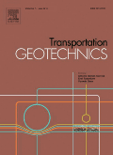
Transportation Geotechnics
Elevating Standards in Transportation Infrastructure.Transportation Geotechnics is a premier academic journal published by Elsevier, focusing on the intersection of geotechnical engineering and transportation systems. With an impressive impact factor and categorized in the Q1 quartile across multiple disciplines including Civil and Structural Engineering, Geotechnical Engineering, and Transportation, this journal stands as a vital resource for researchers and practitioners alike. It covers a broad spectrum of topics ranging from soil behavior in transport contexts to innovative materials and methods that enhance infrastructure stability and performance. As an essential platform fostering knowledge dissemination, Transportation Geotechnics enables contributors to share their groundbreaking findings while providing readers with access to cutting-edge research and reviews from 2014 to 2024. Its illustrious Scopus rankings place it prominently in the global research landscape, making it an indispensable tool for students, professionals, and academics dedicated to advancing the field.
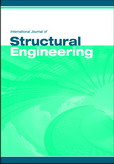
International Journal of Structural Engineering
Connecting Theory with Practice in Structural EngineeringInternational Journal of Structural Engineering, published by InderScience Enterprises Ltd, has established itself as a vital resource in the field of civil and structural engineering. With an ISSN of 1758-7328 and an E-ISSN of 1758-7336, this journal is dedicated to disseminating high-quality research that addresses contemporary challenges and innovations in structural engineering. The journal operates under a rigorous peer-review process, ensuring that only the most impactful and relevant studies are shared with the global community. Since its inception in 2009, the journal has been recognized for its contributions, earning a ranking in Q3 for civil and structural engineering under the 2023 Category Quartiles and occupying the 40th percentile in Scopus rankings. While currently not an open-access journal, it provides access to a wide array of original papers, reviews, and case studies that are crucial for fostering academic discourse and supporting the ongoing education of professionals and students alike. As it continues to expand its reach until 2024, the International Journal of Structural Engineering remains a cornerstone for those seeking to enhance their knowledge and practice in the dynamic realm of structural engineering.
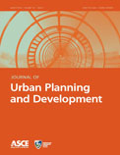
JOURNAL OF URBAN PLANNING AND DEVELOPMENT
Fostering Sustainable Growth in Urban Landscapes.The JOURNAL OF URBAN PLANNING AND DEVELOPMENT, published by the ASCE-AMER SOC CIVIL ENGINEERS, stands as a pivotal platform in the realms of urban studies, civil and structural engineering, and development. With an ISSN of 0733-9488 and E-ISSN of 1943-5444, this journal aims to disseminate high-quality research addressing critical urban planning challenges, fostering innovative solutions, and contributing to sustainable development practices. Spanning from its inception in 1979 to the anticipated issues up to 2024, the journal proudly occupies the Q2 category across multiple disciplines, including Civil and Structural Engineering, Development, Geography, Planning and Development, and Urban Studies. Its noteworthy Scopus rankings reflect its influence, notably being positioned in the 76th percentile in Urban Studies. With no open access options currently available, the journal remains a selective forum for scholarly discourse, attracting researchers, professionals, and students eager to engage with cutting-edge developments in urban planning and design.
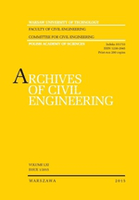
Archives of Civil Engineering
Bridging Theory and Practice in Civil EngineeringArchives of Civil Engineering is a premier academic journal published by POLISH ACAD SCIENCES, dedicated to advancing the field of civil and structural engineering. Established in 1996, this open-access journal has been pivotal in disseminating high-quality research and innovation in engineering practices, particularly since adopting open access in 2010. With an ISSN of 1230-2945 and E-ISSN of 2300-3103, it enjoys a notable reputation, currently ranked in Q3 of the Civil and Structural Engineering category for 2023, reflecting its considerable contribution to scholarly content in the discipline. The journal caters to a diverse audience of researchers, professionals, and students, providing them with a platform to share and access essential findings. Its commitment to high academic standards is underscored by its ranking in Scopus, where it stands at Rank #265/379. Located in Warsaw, Poland, the journal aims to promote international collaboration and foster knowledge exchange in civil engineering, making it an indispensable resource for anyone involved in this dynamic field.